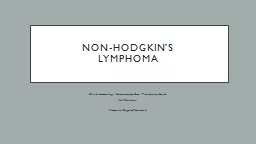

Klinika Hematologii Nowotworów Krwi i Transplantacji Szpiku We Wrocławiu Aleksandra BoguckaFedorczuk Definition Non Hodgkin lymphoma NHL is a heterogenous group of neoplasm ID: 913221
Download Presentation The PPT/PDF document "Non- Hodgkin’s L ymphoma" is the property of its rightful owner. Permission is granted to download and print the materials on this web site for personal, non-commercial use only, and to display it on your personal computer provided you do not modify the materials and that you retain all copyright notices contained in the materials. By downloading content from our website, you accept the terms of this agreement.
Slide1
Non-Hodgkin’sLymphoma
Klinika Hematologii, Nowotworów Krwi i Transplantacji Szpiku
We Wrocławiu
Aleksandra Bogucka-Fedorczuk
Slide2Definition Non-Hodgkin lymphoma (NHL)
is
a
heterogenous
group
of
neoplasm
charecterised
by
clonal
proliferation
of
lymphoid
cells
.
Different
subtypes
of NHL
develop
at
different
stages
of
lymphocytes
B, T
or
NK
differentation
Slide3How does it start?
Slide4How does it start?
Slide5Dysregulation
of
oncogens
expression
,
Example
:
oncogene
c-MYC
oncogene
BCL2nncogene BCL6
Supressor gens mutationsExample:gene P53
Uncontrolled
clonal proliferation
Slide6Slide7B-Cells help make antibodies, which are proteins that attach to and help destroy antigensLymphomas are caused when a mutation arises during the B-cell life cycleVarious different lymphomas can occur during several different stages of the cycle
Follicular lymphoma, which is a type of B-cell lymphoma is caused by a gene translocation which results in an over expressed gene called BCL-2, which blocks apoptosis.
B-Cell Lymphoma (80%)
Slide8T-Cell Lymphoma (15%)
The T-cells are born from stem cells, similar to that of B-cells, but mature in the thymus.
They help the immune system work in a coordinated fashion.
These types of lymphomas are categorized by how the cell is affected
Anaplastic Large cell Lymphoma, t-cell lymphoma caused by a gene translocation in chromosome 5
Slide9Usually classified by how the cells look under a microscope and how quickly they grow and spread
Indolent
Lymphomas (low-grade lymphomas)
-
Indolent – these lymphomas grow slowly.
G
enerally
considered incurable with chemotherapy and/or radiation therapy (FOLLICULAR LYMPHOMA)
Aggressive
– these lymphomas have a rapid growth pattern. This is the second most common form of NHL and are curable with chemotherapy (Diffuse large B-cell lymphoma – DLBCL
)
Very
agressive – Burkitt Lymphoma
Classification
Slide10Most
common
?
Slide11Slide12Risk factors
Infectious
factors
(EBV, HIV, HCV,
H.pylori
)
Autoimmune
diseases
Sex: Male
AgeExposure to herbicides, solvent etc,
Slide13When to think about it
?
Symptoms
:
Enlarged
lymph
nodes
! (
peripheral
but not always)Usually painless, without skin changes, speed of the growth depends on NHL subtype. Sometimes
causes other symptoms by pressing against a vein (swelling of an arm or leg), or against a nerve
Slide14Sometimes
involvement
of
nonlymphatic
structures
Slide15When to think about it
?
Reccuren
fevers
Weight
loss
Night
sweats
FatigueHepatospleenomegalyBonepainReccurent infectionsExtranodal: intestinal (
abdominal pain, dysfagia) CNS (headache, cranial nerve palsies Skin, Thyroid,
Lungs- Pancytopenia (not always: onlywhen
bone marrow involvement)
B
symptoms
(
systemic
symptoms
)
Slide16Biopsy
-
diagnosis
!
Blood tests (complete blood count, LDH, liver and kidney function
)
Staging
procedures
:
CT scans
or
PET-
scan
(necessary to perform the staging and to
control
response
to the
treatment
)
Sometimes
X-
ray
or
Magnetic Resonance Imaging (MRI)
B
one
marrow
biopsy
and
aspirate
Diagnosis
FL
DLBCL
Diagnosis
Slide17Ghielmini
M.,
Montoto
S.
Lymphomas
Essential
for
Clinicians
. ESMO Press, 2016
Slide18Diagnosis - staging
Ann
Arbor
staging
:
stage
I, II, III, IV
divided
into
category
A (no B
symptoms
), B (B symptoms)
or
E (
nonlymphatic
organ
involved
).
IPI (International
Prognostic
Index), MIPI
staging
(
Mantle
Cell Lymphoma
Prognostic
Index), FLIPI (
Folicular
Lymphoma International
Prognostic
Index)
based
mostly
on
age
, Ann
Arbor
stage
, LDH
evaluation
,
extranodal
involvement
and performance status
Slide19Stage I : Involvement of single LN region (I) or extra lymphatic site (IAE )
Stage II
:
Two or more LN regions involved (II) or an extra lymphatic site and lymph node regions on the same side of diaphragm
Stage III
:
Involvement of lymph node regions on both sides of diaphragm, with (IIIE) or without (III) localized extra lymphatic involvement or involvement of the spleen (IIS) or both (IISE)
Stage IV
:
Involvement outside LN areas (Liver, bone marrow)
Diagnosis
-
staging
Slide20Chemotherapy
Radiation
Bone Marrow Transplantation
Immunotherapy
Using the
anty
bodies
against
antigens
of a
cells
(
Rituximab
–
anti CD20 antibody) combined with material made in a lab.
Treatment
options
www.pharmacodia.com
Slide21THANK YOU!